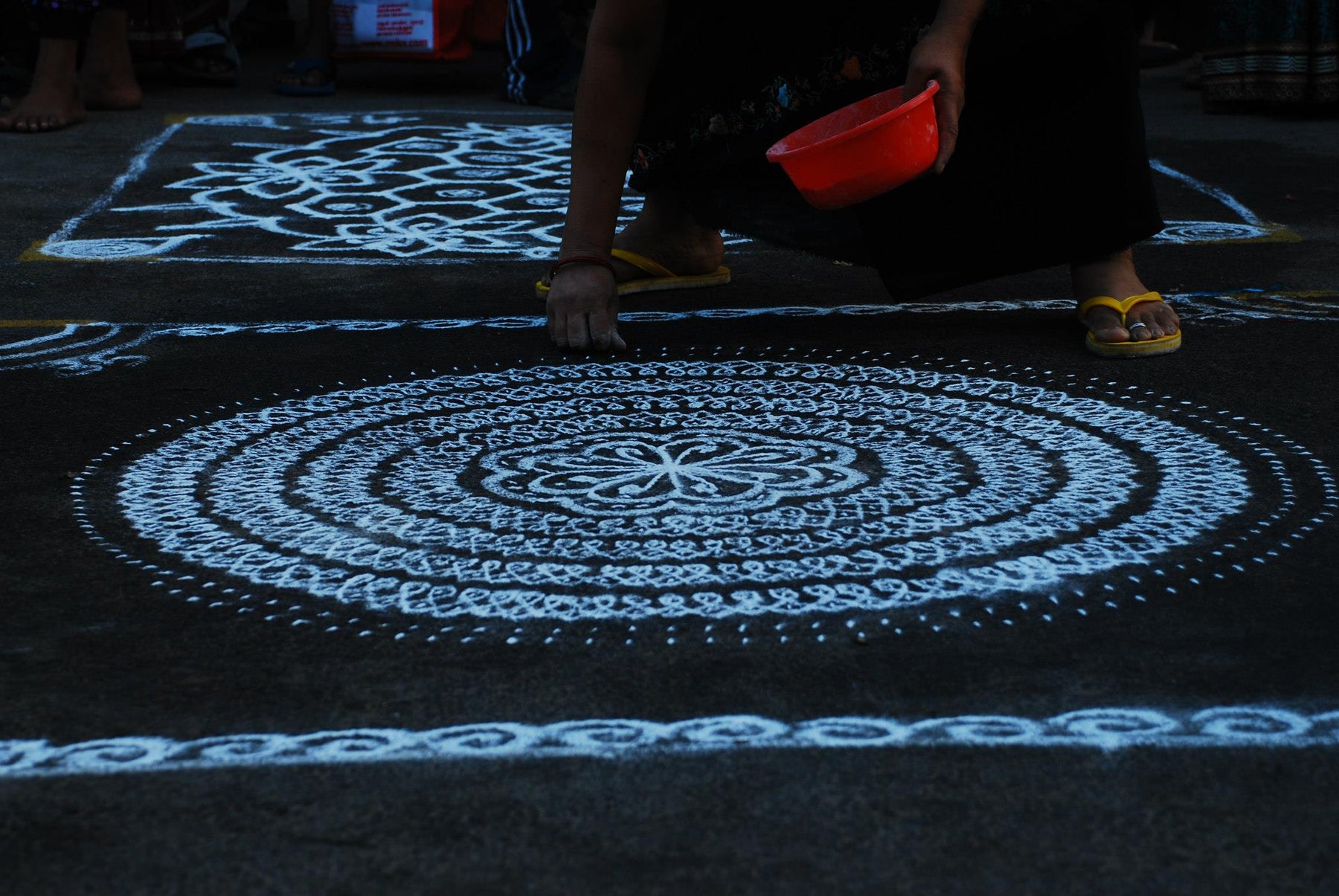
Auspicious Beginnings
Kolam is the traditional Indian art form of drawing intricate geometric patterns on the ground, especially at the entrance to homes and temples, at weddings or festivals. Kolam is the understated South Indian cousin of the flamboyant rangoli of North India. The designs may appear as simple geometric patterns on the threshold, drawn with white chalk powder, but in reality, Kolam is essentially a meticulous mathematical and art form which invites good health and prosperity to the house.
The significance behind Kolam is not just artistic, but more importantly, it also has an auspicious significance. Courtyards and entrances to homes were decorated with kolam and some pavements outside the home may even have permanent kolams painted on them, in white. Essentially a welcome sign, the kolams get bigger on festive days and Fridays. Kolams are drawn to welcome God to the home, to ward off evil or as a gesture of hospitality. It symbolizes fertility, often drawn by married women.
Drawing a kolam outside the house is almost like a stipulated daily ritual. Early in the morning, the area is cleaned and washed with water before tracing the design. Taking a pinch of rice flour powder between the thumb and the forefinger, the lady of the house draws a continuous pattern. Sometimes dots are first drawn and then connected to create a design. Most women have watched their mothers draw the kolam since childhood, so it is almost like a legacy and comes naturally to almost every woman in the South.
Perhaps the most popular kolam designs are geometric. The most popular being “Brahma’s Knot”- a series of curved lines and loops, interspersed with dots to create a geometrically perfect pattern. Kolam patterns are drawn with absolute and aesthetic symmetry. Sometimes curved lines swirl like a border and are filled in with dots on the curves. The designs are usually traditional and handed down from generation to generation, but there are no hard and fast rules, and the artist can let her imagination soar.
Kolam designs go beyond the geometric. Peacock, bird and fish silhouettes rub shoulders with plump paisleys, moon and sun motifs. Blooming lotus or floral designs stand entwined in swirling vines. Rice or chalk powder is used to draw the outline, sometimes filled with coloured rice or coloured powder. In villages, the month of Maargazhi, is celebrated with young girls drawing kolams and filling them with a sumptuous helping of pumpkin flower petals. Often, kolam competitions are organized.
The humble Indian kolam was the Indian ambassador at the virtual kick-off ceremony, when U.S President elect Joe Biden and the Vice President elect, Kamala Harris were sworn in. Thousands of kolam tiles were made as a tribute to the first woman and first Indian origin Vice President, by over 1800 people of Indian origin. This online initiative spawned creative designs to commemorate this historic event. Woven into an engaging video, these designs augur new beginnings and reflect the multi-cultural heritage of the U.S.
Kolams may beautify the threshold, attract the Gods, beckon positive energy or keep the evil spirits away, but they boast of much more. The fact that they are drawn early morning implies that the lady of the house wakes up early. Cleansing the threshold before making the Kolam also signifies hygiene. Bending down to draw a Kolam is exercise itself and keeps the body supple, whilst it also mirrors the lady’s artistic talents. Replicating these designs repeatedly is known to exercise the brain, improve coordination and sharpen the eyesight.
This art of drawing magical motifs and abstract designs probably dates back to the pre-Aryan period, 5000 years, but remains equally relevant till date. Today, the mathematical properties of kolams are being used to inspire algorithms, used for research in Computational Anthropology and also in the picture drawing computer software. These designs are often used in the field of art and media. The intricate twists and turns of kolam designs, perhaps, symbolically, mirror the journey of life, with its ups and downs.
With an eye on symmetry, complexity and precision, at Sarangi we strive to keep alive this traditional Indian legacy of perfection in design, taking it to an exalted level.